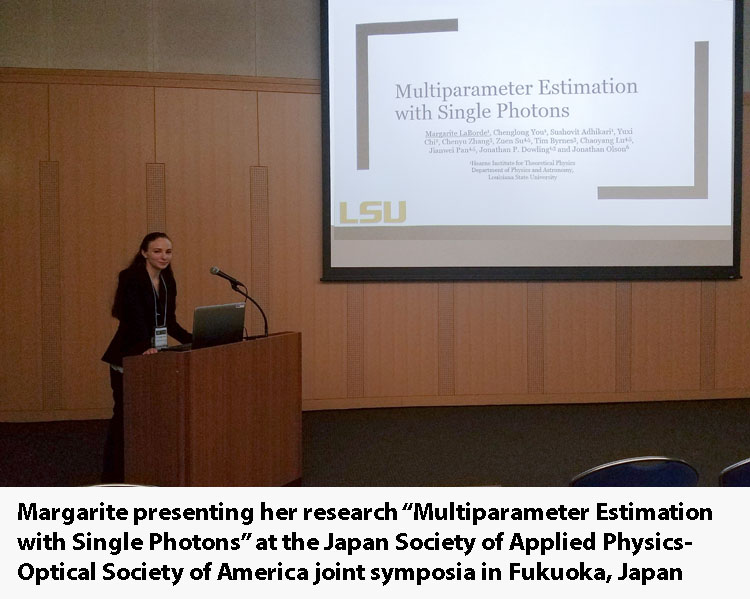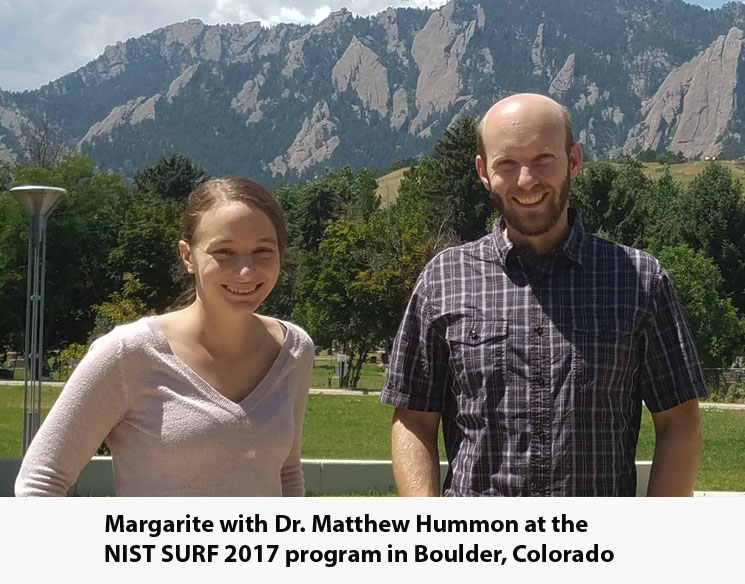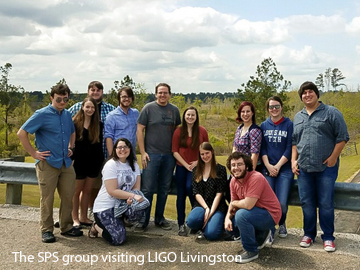Student Spotlight: Margarite LaBorde, a double major in physics and math
 Margarite, a native of the Baton Rouge area, is passionate about physics research.
She participated in the National Institute of Standards and Technology (NIST) Summer
Undergraduate Research Fellowship (SURF) program and recently presented some of her
research "Multiparameter Estimation with Single Photons" at the Japan Society of Applied
Physics-Optical Society of America joint symposia in Fukuoka, Japan thanks in part
to the LSU Discover Travel Stipend!
Margarite, a native of the Baton Rouge area, is passionate about physics research.
She participated in the National Institute of Standards and Technology (NIST) Summer
Undergraduate Research Fellowship (SURF) program and recently presented some of her
research "Multiparameter Estimation with Single Photons" at the Japan Society of Applied
Physics-Optical Society of America joint symposia in Fukuoka, Japan thanks in part
to the LSU Discover Travel Stipend!
The 2017-18 president of the Society of Physics Students – LSU Chapter, Margarite recently sat with the LSU College of Science to talk about her experience as an undergraduate student in physics.
What do you love most about physics?
Margarite: “I love the focus on problem solving. I think of physics as the act of putting together the puzzle pieces of nature, and mathematics is the language used to describe that process.”
What excites you most about doing science on a regular basis?
Margarite: “My favorite thing about doing science on a regular basis is how you feel constantly intellectually stimulated. What you’re doing is always interesting and new, and you always have new questions to answer. Of course, there are always setbacks when reality doesn’t follow your expectations. When items break or you can’t get the data you need, you just have to try to approach your problems in new ways.”
What’s the oddest or craziest thing you’ve done “for science”?
Margarite: “I did some anodic bonding at NIST, which involves a hot plate and high voltages. The voltage wasn’t much of a problem, but I was constantly trying to adjust a preform on a 300 Celsius hot plate. That was intense!”
Can you tell us a story about a recent research experience you’ve had?

Margarite: “Last summer, I participated in the NIST SURF program in Boulder where I got to work in an optics lab. I had the opportunity to work with and learn about an external cavity diode laser, optical equipment, anodic bonding, and machining equipment. This was the first time I had done experimental research, so the learning curve was high. By the end of the summer, I was able to successfully perform spectroscopy on rubidium atoms with frequency-doubled laser light.”
Can you tell us about your experience with SPS and the opportunities this group offers?
I originally got involved with SPS in an effort to be more social. SPS has a lot of opportunities to just hang out and have fun with your fellow physics majors, be it trips or nerf wars or karaoke sessions. After joining SPS, I’ve also had the chance to participate in and organize many STEM outreach events. There’s something really fun and engaging about getting to explain physics to children and other members of the community. I enjoyed being a part of SPS for both of these things, but I feel there’s a lot of benefit for people who want just the science or just the social aspect as well.
How has LSU Physics provided you with research opportunities as an undergrad working with Dr. Dowling?
 I was very fortunate to begin working with Dr. Dowling as soon as I began my freshman
year. During the time I have been participating in research, the physics department
has helped me in a myriad of ways. Perhaps most notably, they were instrumental in
my application to the NIST SURF program—which could only be submitted through the
department—and in making my trip to the conference in Japan possible.
I was very fortunate to begin working with Dr. Dowling as soon as I began my freshman
year. During the time I have been participating in research, the physics department
has helped me in a myriad of ways. Perhaps most notably, they were instrumental in
my application to the NIST SURF program—which could only be submitted through the
department—and in making my trip to the conference in Japan possible.
What advice do you have for students pursuing a degree in physics?
Margarite: “The most important skill you can learn is how to work alone, and when to ask for help.”